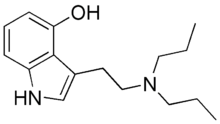4-HO-DPT
4-HO-DPT (4-hydroxy-N,N-dipropyltryptamine) is a lesser-known psychedelic drug. It is the 4-hydroxyl analog of dipropyltryptamine (DPT). 4-HO-DPT was first synthesized by Alexander Shulgin. In his book TiHKAL, neither the minimum dosage nor the duration are reported.[1] Very little data exists about the pharmacological properties, metabolism, and toxicity of 4-HO-DPT.
 | |
| Legal status | |
|---|---|
| Legal status |
|
| Identifiers | |
IUPAC name
| |
| CAS Number | |
| PubChem CID | |
| ChemSpider | |
| CompTox Dashboard (EPA) | |
| Chemical and physical data | |
| Formula | C16H24N2O |
| Molar mass | 260.381 g·mol−1 |
| 3D model (JSmol) | |
SMILES
| |
InChI
| |
| | |
In November 2019, Chadeayne et al. published the crystal structure of 4-HO-DPT, bis(4-hydroxy-N,N-di-n-propyltryptammonium)-fumarate.[2] The authors describe the structure as "…a singly protonated DPT cation, one half of a fumarate dianion (completed by a crystallographic centre of symmetry) and two water molecules of crystallization in the asymmetric unit."
See also
- 4-HO-EPT
- UH-301
References
- 4-HO-DPT Entry in TIHKAL
- Chadeayne, Andrew R.; Pham, Duyen N. K.; Golen, James A.; Manke, David R. (2019-11-28). "Bis(4-hydroxy- N , N -di- n -propyltryptammonium) fumarate tetrahydrate". IUCrData. 4 (11): x191469. doi:10.1107/S241431461901469X. ISSN 2414-3146.
This article is issued from
Wikipedia.
The text is licensed under Creative
Commons - Attribution - Sharealike.
Additional terms may apply for the media files.